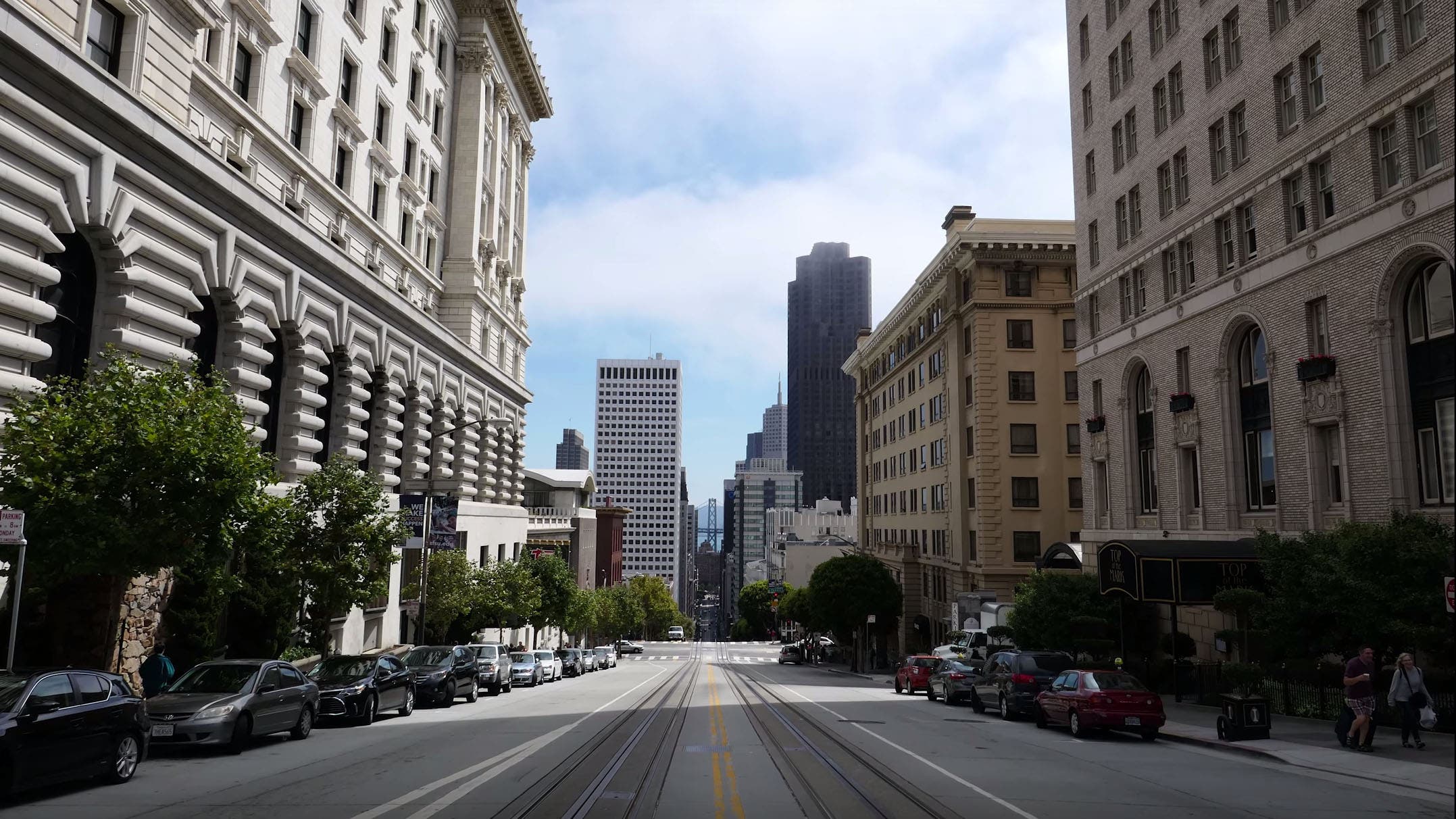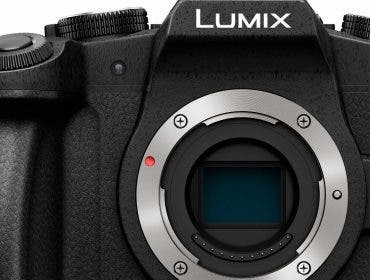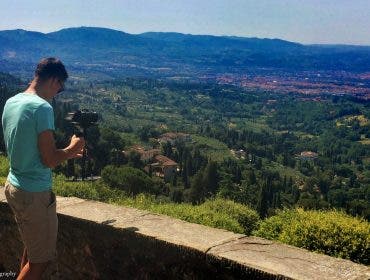Panasonic introduced a new camera to the block this week, the Panasonic Lumix DMC-LX10 digital camera: a perfect-sized compact camera for a shirt-pocket or purse, complete with a Leica 3x DC Vario-Summilux 8.8-26.4mm F/1.4-2.8 lens and an endless number of amazing options.
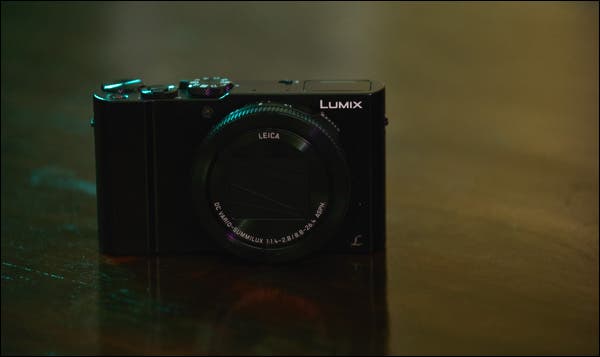
The brand new Panasonic Lumix DMC-LX10 digital camera.
I was able to get my hands on the Panasonic Lumix DMC-LX10 and gave it trial run of my own to see if it was all that it has been hyped up to being. It is currently available for pre-order at Adorama for $697.99.
KEY FEATURES
Just a few of its numerous key features include:
- 1-inch 20.1 MP sensor
- Leica 3x DC Vario-Summilux 8.8-26.4mm F/1.4-2.8 lens
- 3-inch 180 degree upward tilting touchscreen
- 4K Photo and Motion Video recording capability
- Five-axis HYBRID O.I.S.+ image stabilization
- Exposure, aperture, focus and white balance bracketing
- Minimum focusing distance of 3cm (wide-angle) and 30cm (telephoto)
- Numerous focusing options including post-focusing
- Aperture ring
- Built-in WiFi
There are so many features on this camera, many of which I’ll go into more detail below, so let’s get snapping!
BODY DESIGN, ERGONOMICS AND HANDLING
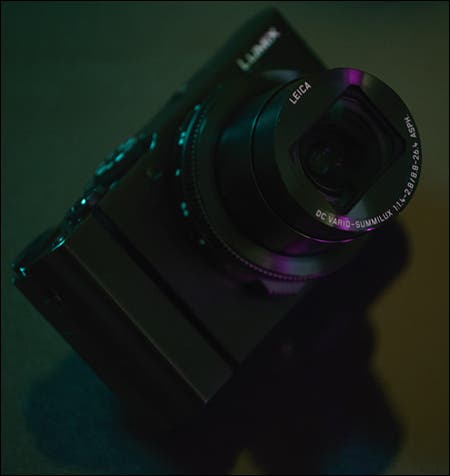
All metal compact body.
As a first-time Panasonic user, I was surprised to find the Panasonic Lumix DMC-LX10 to be such a solid piece of equipment. It has an all-metal seamless body construction with aluminum dials. It is a lot heavier than I thought it would be on first glance, but I have always said there is something to be said about the weight of piece of gear that makes you feel like you have a good, professional product in your hand rather than a cheap, light plastic product that would probably break with a fall (not that I endorse throwing this camera on the ground!). This tiny little powerhouse weighs in just over a half a pound at 280g (0.62 lbs) without the battery and memory card, which is pretty meaty for something with size specs of 4.15 x 2.36 x 1.65 inches (105.5 x 60 x 42mm)! That being said, there was a small learning curve for me to get used to working with something so small considering I regularly shoot with a full frame DSLR. However, with all the features this camera offers, I feel like I am getting a DSLR camera without that annoying and inconvenient bulky size.
Inside, it has a 1-inch high sensitivity 20.1-megapixel MOS sensor that records a variety of quality options, including 4K photos in crisp and sharp detail.
Lens
The Panasonic Lumix DMC-LX10 has a high-quality, built-in Leica DC Vario-Summilux 8.8-26.4mm lens with a fast variable aperture of f/1.4 to f/2.8 covering a 24-72mm zoom range. The lens is constructed of 11 elements in 9 groups. The iris contains 9 blades which lends to yielding a nice bokeh effect.
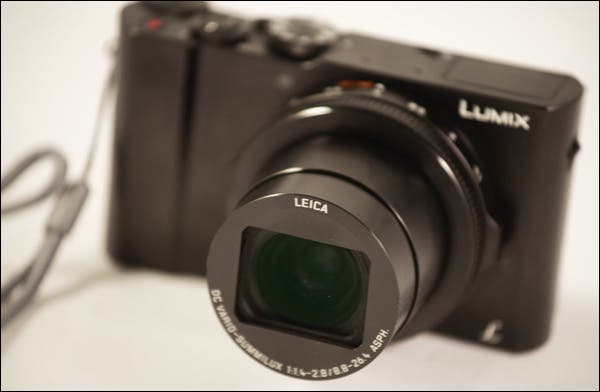
Leica DC Vario-Summilux 8.8-26.4mm lens.
I was delighted by the minimal focusing distance being 3cm (AF macro wide angle) and 30cm (telephoto). Getting that close up shot has never been easier.
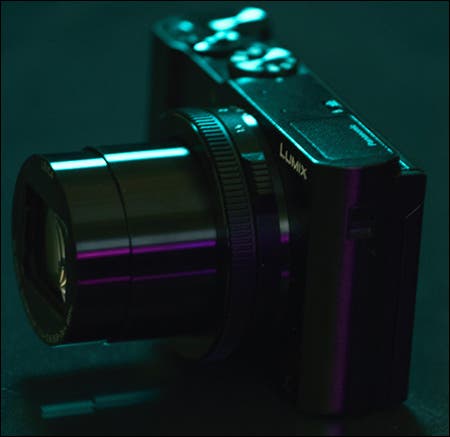
The lens itself measures just under 2-inches in length.
Buttons, Functions & Controls
Speaking of the lens, in addition to control ring, the Panasonic Lumix DMC-LX10 has an aperture control ring located around the lens, which combined with the rear dial, provides for manual control of the camera on important settings such as zoom, focus and shutter speed.
The controls on the top of the camera really do seem to be in good places, despite my slow adjustment to this very small compact camera and locating its settings.
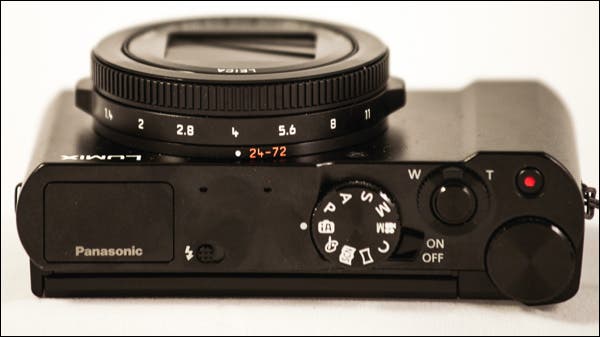
Good location for buttons on top of the camera despite my learning curve – they made sense…
On the right is just about everything you need for shooting: the zoom lever and shutter release, a record button to movies, the rear dial and the mode dial, which contains the usual manual, aperture priority, shutter priority and program modes, but it also has intelligent auto, movie, panorama, 24 scene modes and approximately 22 creative control filters under the creative mode. On the back of the camera are the following button options: 4K Photo, playback, quick menu, set, focus mode/left arrow, drive mode/down arrow, exposure compensation/up arrow and white balance/right arrow, trash/quick menu. The Panasonic Lumix DMC-LX10 provides for spot, center-weighted and Intelligent Multiple exposure metering options. Exposure bracketing can be done in 3, 5 or 7 shots. There is also focus, aperture and white balance bracketing.
Display
The Panasonic Lumix DMC-LX10 does not have an external viewfinder, instead using only the 3-inch, touchscreen tilt LCD monitor as the way to frame the image for capture. The 180-degree upward tilt is perfect for those timeless selfies everyone loves to capture.
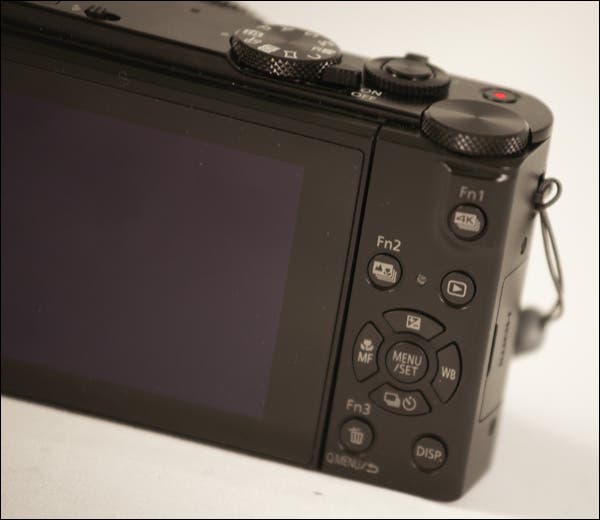
3-inch 180-degree tilt display
Menus
A lot of menus equal a lot of options. I am a huge fan of the Panasonic Lumix DMC-LX10’s scrolling digital explanation of every menu option within the menus. It makes trying to learn a new camera easy – even more so for those that hate reading the manual! Panasonic makes it very easy and very user-friendly to customize your camera settings with ease. I do encourage you to take an hour and read your manual and explore the menus as there are more options than meet the eye for this tiny little dynamo.
Flash
Unlike many cameras, the Panasonic Lumix DMC-LX10 lacks a hotshoe for external flash. Instead, it has a built-in flash located on the top of the camera on the left side that has an approximate 20-40 foot illumination range.
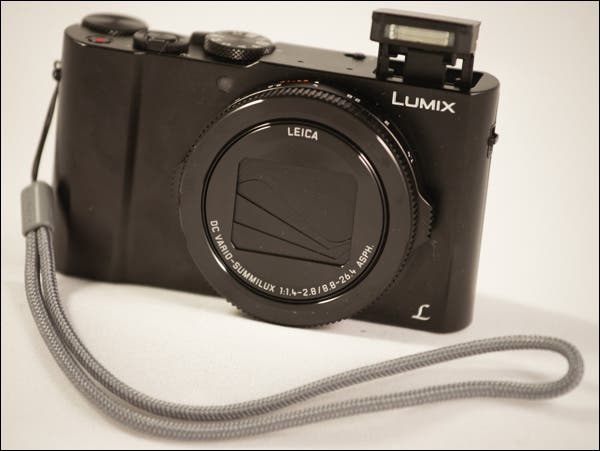
Built-in pop-up flash
AUTOFOCUS & PERFORMANCE
High performance and good autofocus are important factors when the opportunity arises to capture an image.
Speed and Continuous Shooting
Speed is always a key factor in purchasing a new camera. The most common concern would be: will I miss the moment? The Panasonic Lumix DMC-LX10 does not disappoint! It shoots up to 50 frames per second using the electronic shutter, 10fps with a mechanical shutter and 6fps using continuous autofocus. If you are shooting sports, running children or even this shaky little impatient guy below, this camera will meet your expectations.

You need a high performance camera to capture moving objects. Shot at ISO 3200, f/2.8 at 1/125 of a sec.
Focusing Options
There are several focusing options available on the Panasonic Lumix DMC-LX10 to help get your images sharp and in-focus.
Capture Focusing Modes
The Panasonic Lumix DMC-LX10 offers many focus modes for capturing an image: general autofocus, face-eye detection, one area, pinpoint, tracking and custom modes. Additional modes are focus peaking, starlight autofocus and low-light autofocus.
For some of us that can’t help to to drink tea or coffee when we shoot, there are also post-capture features for focusing!
Post Focusing
The feature to blow my mind was the Post Focus feature. Using the post focus feature in 4K Photo mode, you end up shooting a burst of consecutive frames with different focus distances. You can then choose an image from the burst that has the focus point you intended.
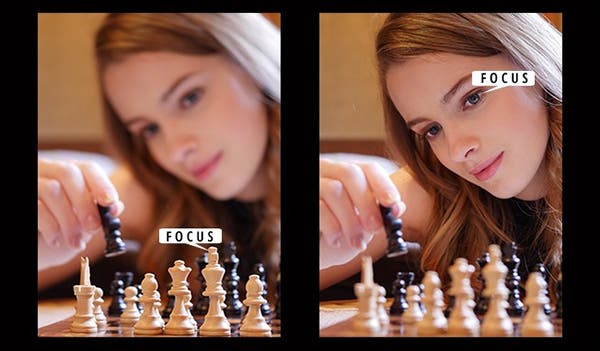
Choose your focus point using 4K Photo mode.
Focus Stacking
The focus stacking option allows you to obtain your focus with more depth of field by stacking the multiple images of a subject. You must be in 4K Photo mode to use this feature.
The lens on this camera also has 5-axis Hybrid O.I.S.+ image stabilization to also help keep your images sharp when working in low-lighting conditions.
IMAGE QUALITY
4K Photo
If the 4K video resolution quality from TVs gives you any clue, 4K video and photo produced from this digital camera is going to put digital imaging into a whole new playing field. By setting the Panasonic Lumix DMC-LX10 in 4K Photo mode, you are essentially able to choose a still image from the 4K video produced. The LX10 can shoot 4K video at 30fps for up to 15 minutes allowing you to choose your best still frame after shooting.

Extracted frame using 4K Photo mode.

Beautiful color and resolution using 4K Photo mode.

Didn’t miss this little guy getting away by using the 4K Photo mode.
Colors
It’s always a challenge to find a camera that produces exceptional images every time. The color rendering from this camera is pretty spot on. As you look on the LCD prior to the shot, you pretty much see what your result is going to be prior to pressing the shutter.

Terrific image quality. Shot at ISO 1600, f/2.8 and 1/25 of a sec.

Exquisite color rendering. Shot at ISO 640, f/1.4 at 1/125 of a sec.

Beautiful, crystal clear images in lower lighting conditions (just after sunset).

Great macro capability too.
The LX10 offers in-camera RAW processing so that you can shoot, adjust and upload by its built-in WiFi feature – on the go.
ISO and Noise
The high native ISO sensitivity for the Panasonic Lumix DMC-LX10 runs from 125 to 12800 with extended to ISO 25600. I found my images at ISO 3200 to still be pretty darn sharp and free from noise (dog image above and image below).

My hallway is pretty dark and no noise here at ISO 3200.
Video
As mentioned previously, the LX10 has 4K video capability of 30p/100Mbps which is what allows for capturing 8MP still images at up to 30fps. This camera additionally has a 4K Live Cropping feature which allows you to zoom or pan seamlessly. Full HD video mode also allows for Live Cropping but in addition, has 5-axis HYBRID O.I.S.+ which helps compensate for five types of movement to help reduce camera shake. This is not available in 4K mode or high speed recording mode.
CONNECTIVITY, SOUND AND POWER OPTIONS
The Panasonic Lumix DMC-LX10 charges by a USB 2.0 Micro-B port. An optional battery charger is available though you don’t really need it unless you’re buying more than one battery. It offers a Micro-HDMI Type-D port and also has built-in WiFi for wireless image sharing and to provide for remote control from mobile devices. It also has a built-in microphone and speaker for video and playback.
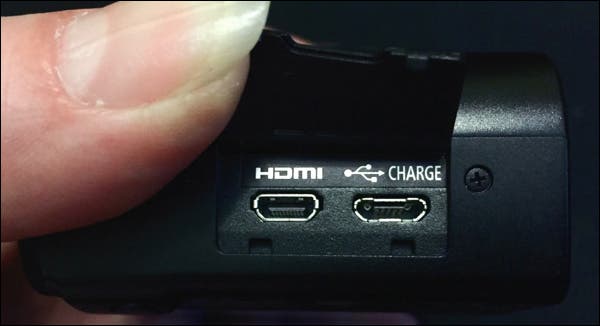
HDMI and charge ports.
STORAGE
This little gizmo accepts SD Memory Cards (512MB to 2GB), SDHC Memory Class 3 Cards (4GB to 32GB) and SDXC Memory Class 3 Cards (48GB to 128GB). The storage and battery compartment is located on the bottom side of the camera.

Memory card and storage compartment inside the bottom of the camera.
WHAT’S IN THE BOX
The Panasonic Lumix DMC-LX10 is ready to go with just about everything you need to start shooting (just add a memory card, of course!):
- Digital Camera
- Battery Pack
- AC Adaptor
- USB Connection Cable
- Handstrap
- Owner’s Manual
PROS and CONS
Pros:
- Small, durable size
- Fast focus and capture speed
- 4K Photo and motion video recording capability
- Great image stabilization
- Excellent color rendering
- Excellent focusing capabilities and options to get it done
- Built-in WiFi
- Tilting touchscreen for all of you “selfie-ographers” out there
Cons:
- Unable to edit RAW in Lightroom
- Grows a little warm with extensive non-stop use
WHO ITS FOR
A landscape photographer’s dream. A street photographer’s delight. The child or pet photographer’s hero. A travel photographer’s companion. The videographer’s new best friend. This is a convenient, anytime, multipurpose compact camera.
MY TEN CENTS ON THIS CAMERA…
The Panasonic Lumix DMC-LX10 is a lightweight compact camera that really sets a new bar for creating high-quality images. It’s easy to use, does just about everything you could want it to do, creates quality images and fits easily in a shirt pocket or purse. It’s a superb little camera that can work for just about any purpose.
Cover image courtesy of Panasonic USA. Full sample footage can be seen here:

